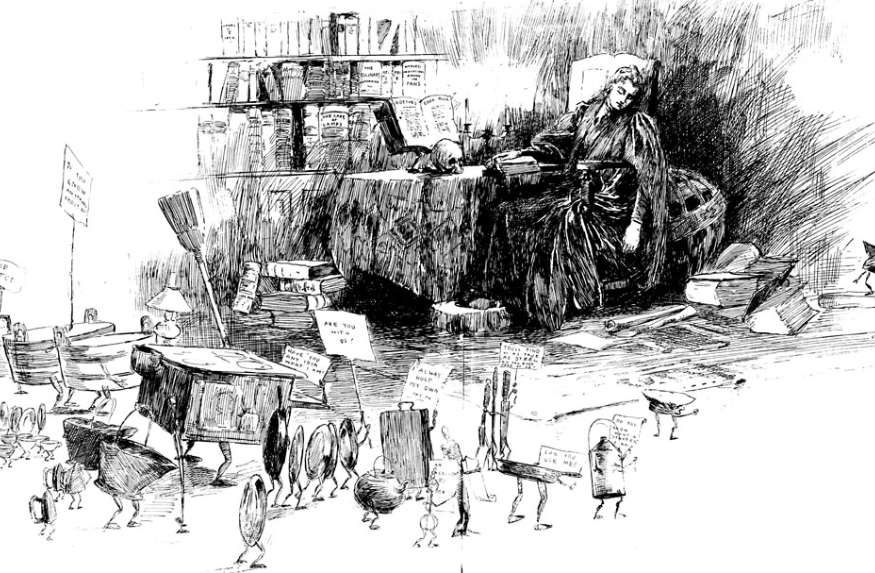The source I chose consists of a black-and-white image by Charles Howard Johnson titled For the benefit of the girl about to graduate, created in the 1890s. Johnson’s image is published in American Women: A Library of Congress guide for the study of women’s history and culture in the United States. By selecting this cartoon to be included in the Library of Congress, editors show their understanding of the important historical theme in U.S. women’s history- specifically the conflict between women’s education aspirations and domestic expectations. In this image, Johnson depicts a woman sitting at a desk surrounded by books. The woman who appears to be sleeping looks extremely overworked as she lies in a chair wearing a graduation robe. Marching towards her is a parade of everyday animated household items, such as pots and pans, each carrying protest signs. Some of these signs read demanding and thought-provoking phrases like, “Don’t Forget Us” and “Are you still with us?”, portraying themselves as personified objects with determined expressions.
Although this image doesn’t have information explaining its significance, viewers can notice the underlying message it is trying to convey. This image brings up a serious conversation about gender, labor, education, and domestic life for women during this time period. As a result, the women portrayed in this image become a valuable source. Not only does it capture the gender roles and stereotypes women faced, but it also shows that they worked towards achieving equal rights and education.
To fully understand the depths of this image, it is important to consider women’s expectations during this time period. Jill K. Conway explains in her journal article, Perspectives on the History of Women’s Education in the United States, how men often believed women’s education should reinforce their domestic responsibilities. Conway notes Benjamin Franklin’s views that “women’s happiness was to be found in marriage and reason therefore decreed that women should be educated to use their rational powers in the role of wife and mother.” (Conway 1974). Franklin’s opinion supported the 19th-century belief that women’s education should be based on domestic goals, rather than personal, independent purposes. This demonstrates how education was seen as a way to provide women with resources in becoming better wives and mothers, supporting the image’s illustration representing a similar tension. The woman in the image, being surrounded by books at a desk, shows her goals of pursuing education; however, the household items threateningly walking towards her show society’s demands for her to shift focus back on domestic expectations.
In the late 19th century, a greater number of women sought higher education, including scientific work; however, the opportunities they had were often limited due to sex-segregated roles. In another journal article from Margaret W. Rossiter called “Women’s Work” in Science, 1880-1910, Rossiter explains how, “As a result, women were incorporated into the world of scientific employment but segregated within it, as the prevailing stereotypes of appropriate sexual roles interacted with expanding scientific research work and changing research strategies between 1880 and 1910.” (Rossiter 1980). Rossiter’s analysis explains how, even when women entered higher education or scientific work, they were steered by gender roles. This is seen within Johnson’s image, where the household items are trying to regain the woman’s attention
To support this idea, Ralph H. Turner uses a sociological perspective to understand role change and the underlying message of this image. In his article Role Change Turner states, “Historical research has shown that the now eroding pattern of husband as exclusive breadwinner with wife limited to domestic duties was only a temporary aberration from the typical pattern of full participation by both husband and wife in economic production. The critical change brought on by industrialization was separation between the locus of economic production and the home, leading to a sharper division of economic and domestic responsibilities between husband and wife roles.” (Turner 1990). By understanding Turner’s sociological perspective, viewers can see how women’s situations are being illustrated through Johnson’s work. During the 19th century, men’s employment involved them being away from home, and that is when women’s roles were strictly based on their responsibility for the household.
Tying this into Johnson’s image, we can see how the woman within this picture appears to be torn between both of these worlds-education and domestic obligations. Johnson’s image reveals a message of how women’s progress was constrained by the historical beliefs during the 19th century. Overall, this picture sheds great light on women’s education and work being weighed down by the expectations to fulfill domestic life. However, as time went on, women were able to take control of their lives, reflecting on how far society has come when redefining gender roles and expectations that still linger today, which is why I believe this source is significant for this virtual museum.
Work Cited
Conway, Jill K. 1974. “Perspectives on the History of Women’s Education in the United States.” History of Education Quarterly 14 (1): 1. https://doi.org/10.2307/367602.
Johnson, Charles Howard . 1890. “For the Benefit of the Girl about to Graduate/ Charles Howard Johnson.” Library of Congress . 1890. https://www.loc.gov/item/2002712165/.
Rossiter, Margaret W. 1980. “‘Women’s Work’ in Science, 1880-1910.” Isis 71 (3): 381–98. http://www.jstor.org/stable/230118.
Turner, Ralph H. 1990. “Role Change.” Annual Review of Sociology 16: 87–110. https://doi.org/10.2307/2083264.
